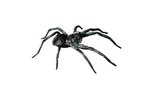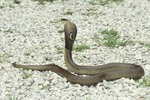
The unwary victim who places a foot or hand in the wrong place may find himself fighting for his life, bitten or stung by one of the world's most venomous animals. It's not just the venom, it's the amount of venom released and how quickly he receives treatment that may determine whether he lives -- or dies.
Sea Creatures
The vast oceans of the world harbor the most venomous creatures known to man, including the box jelly (Chironex flecker), also known as the sea wasp. Native to the South Pacific, the deadly barbs on its tentacles have caused more than 5,500 excruciatingly painful deaths since 1884, mostly along Australian beaches.
Other venomous sea creatures include the reef stonefish (Synanceia verrucosa) and two species of the blue-ringed octopus, the lesser (Hapalochlaena maculosa) and the greater (Hapalochlaena lunulata). These coral reef and tidepool dwellers prefer the warm, shallow waters of the Pacific and Indian oceans, from Japan to Australia. While the stonefish's venom produces extreme pain, the blue-ringed octopus' bite is often unnoticed until the victim experiences weakness and numbness leading to paralysis and death. There is no antivenin for the octopus' bite, but with continuous artificial respiration for up to 24 hours, the venom dissipates and the victim usually survives.
Snakes
While Australia's inland taipan (Oxyuranus microlepidotus) venom is the considered the most toxic in the world, there are no known human deaths from this snake, thanks to quick antivenin treatment of its victims. In contrast, the black mamba (Dendroaspis polylepis) of Africa has a 100 percent mortality rate if not treated immediately. The black mamba is known for its aggressive behavior, striking and injecting venom multiple times. Each bite contains enough venom to kill several humans. Other extremely dangerous venomous snakes include the saw-scaled viper (Echis carinatus), native to southwestern Asia and the Middle East, and southern Asia's king cobra (Ophiophagus hannah).
Spiders
Many spiders bite and inject venom when threatened. Among the most toxic spiders are Australia's Sydney funnel web spider (Atrax robustus) and the Brazilian wandering spider (Phoneutria nigriventer). Native to Australia and Papua New Guinea, funnel web spiders are normally found in rock crevices and burrows and around house foundations, finding their way indoors in wet weather. Before an antivenin was developed, the Sydney funnel web spider's venom caused 13 known deaths. Meanwhile, the next most toxic spider is the Brazilian wandering spider. Approximately half of all spider bite hospitalizations in South America are due to wandering spiders' venom.
Yellowjackets, Hornets and Bees
While the venom from bee stings isn't as toxic as that of other creatures, an allergic reaction can kill you within an hour. Yellowjackets (Vespula spp.) and hornets (Dolichovespula spp.) are particularly dangerous because of their aggressive behavior and ability to sting and inject venom multiple times. In contrast, Africanized honey bees (Apismellifera scutellata Ruttner), also known as killer bees, can only sting you once. When the hive is aroused, however, hundreds of bees swarm onto the trespassing victim, who may suffer several hundred or a thousand stings in just a few minutes.
References
- University of Utah Health Care: Utox Update -- Marine Envenomations
- Animal Diversity Web: Chironex Fleckeri
- Australian Museum: Reef Stonefish, Synanceia Verrucosa (Bloch & Schneider, 1801)
- MarineBio: Blue-ringed Octopuses, Hapalochlaena Maculosa
- Department of Wildlife Ecology & Conservation: Frequently Asked Questions About Venomous Snakes
- African Reptiles & Venom: Black Mamba
- Arkive: Sind Saw-Scaled Viper (Echis Carinatus Sochureki)
- Arkive: King Cobra (Ophiophagus Hannah)
- V.I.S.S. Hazard: Venomous Bites and Stings
- Australian Venom Research Unit: Funnel Web Spiders
Resources
- University of Florida IFAS Extension: Stinging or Venomous Insects and Related Pests
- University of Florida IFAS Extension: Featured Creatures -- Yellowjackets and Hornets
- Ohio State University Extension Fact Sheet: Africanized Honey Bee
- UCSB ScienceLine: What Is the Most Poisonous Animal on Earth? How Does its Toxin Work?
- University of Florida IFAS Extension: Venomous Arthropods
Photo Credits
-
Ian Waldie/Getty Images News/Getty Images
Writer Bio
With degrees in fine and commercial art and Spanish, Ruth de Jauregui is an old-school graphic artist, book designer and published author. De Jauregui authored 50 Fabulous Tomatoes for Your Garden, available as an ebook. She enthusiastically pursues creative and community interests, including gardening, home improvement and social issues.




